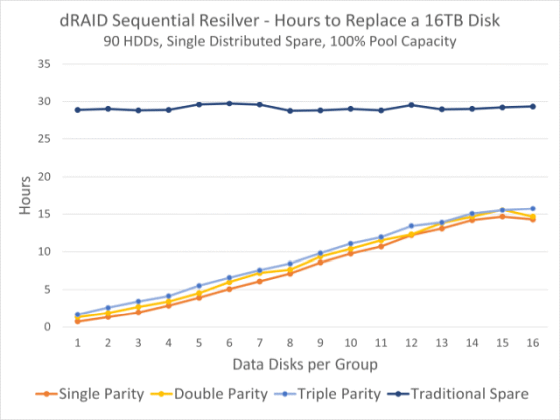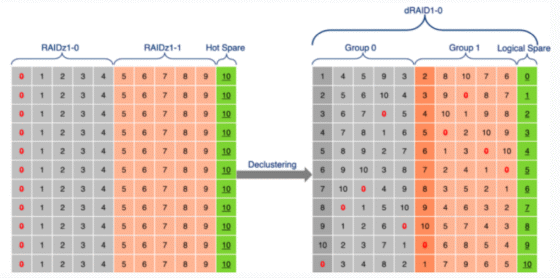What is 'dRAID', a technology that dramatically reduces the RAID rebuilding time in the event of a disk failure?

'
dRAID, Finally! | Klara Inc.
https://klarasystems.com/articles/openzfs-draid-finally/
dRAID — OpenZFS documentation
https://openzfs.github.io/openzfs-docs/Basic%20Concepts/dRAID%20Howto.html
The history of RAID can be regarded as the history of redundancy due to data distribution. In the figure, green represents the parity that protects the data, and yellow represents the hot spare that is the spare area in the event of a disk failure. RAID 4, which was rarely used at the time of writing the article, had a problem that the write speed was limited because the parity was written only to a single disk.

RAID 5 and RAID 6 have solved the problems that RAID 4 had. In these RAIDs, the parity is distributed to each disk to eliminate the write speed bottleneck.

However, since hot spares were still managed by one disk, there was a problem that when a certain disk failed, data writing during recovery was concentrated on the hot spare disk. According to

In response to these problems with RAID 5 and RAID 6, dRAID is a technology that distributes not only parity but also hot spares to each disk as shown in the figure.

By distributing the hot spare to each disk, the RAID rebuilding process in the event of a failure is also distributed to each disk, and the rebuilding process can be speeded up.

Below is a graph comparing the rebuilding time of RAID without checking data integrity between conventional RAID and dRAID. It can be confirmed that dRAID can be rebuilt in a shorter time regardless of the number of parity than the conventional RAID shown in indigo.

The following figure

In normal RAID-Z, it was possible to use the disk capacity efficiently with the variable stripe width, but in dRAID, the rebuilding speed of RAID is emphasized and the stripe width is fixed. If you write a large amount of small data, the available data capacity will be reduced because the part that is less than the fixed stripe width will be padded . As a workaround, OpenZFS recommends adding a special virtual disk to store small data.
dRAID is not installed in the latest OpenZFS at the time of writing the article, but it can be used by compiling the development version from the source code. The official version of OpenZFS will be available in the first half of 2021.
Related Posts:
in Software, Posted by darkhorse_log







